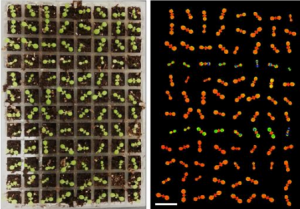DOI: 10.1105/tpc.16.00775
Bile acid sodium symporter BASS6 can transport glycolate and is involved in photorespiratory metabolism in Arabidopsis thaliana
Abstract

![]() Photorespiration is an energy-intensive process that recycles 2-phosphoglycolate, a toxic product of the RubisCO oxygenation reaction. The photorespiratory pathway is highly compartmentalized, involving the chloroplast, peroxisome, cytosol and mitochondria. Though the soluble enzymes involved in photorespiration are well characterized, very few membrane transporters involved in photorespiration have been identified to date. In this work, Arabidopsis thaliana plants containing a T-DNA disruption of the bile acid sodium symporter BASS6 show decreased photosynthesis and slower growth under ambient, but not elevated CO2. Exogenous expression of BASS6 complemented this photorespiration mutant phenotype. In addition, metabolite analysis and genetic complementation of glycolate transport in yeast showed that BASS6 was capable of glycolate transport. This is consistent with its involvement in the photorespiratory export of glycolate from Arabidopsis chloroplasts. An Arabidopsis double knockout line of both BASS6 and the glycolate/ glycerate transporter PLGG1 (bass6, plgg1) showed an additive growth defect, an increase in glycolate accumulation, and reductions in photosynthetic rates compared to either single mutant. Our data indicate that BASS6 and PLGG1 partner in glycolate export from the chloroplast, whereas PLGG1 alone accounts for the import of glycerate. BASS6 and PLGG1 therefore balance the export of two glycolate molecules with the import of one glycerate molecule during photorespiration.
Photorespiration is an energy-intensive process that recycles 2-phosphoglycolate, a toxic product of the RubisCO oxygenation reaction. The photorespiratory pathway is highly compartmentalized, involving the chloroplast, peroxisome, cytosol and mitochondria. Though the soluble enzymes involved in photorespiration are well characterized, very few membrane transporters involved in photorespiration have been identified to date. In this work, Arabidopsis thaliana plants containing a T-DNA disruption of the bile acid sodium symporter BASS6 show decreased photosynthesis and slower growth under ambient, but not elevated CO2. Exogenous expression of BASS6 complemented this photorespiration mutant phenotype. In addition, metabolite analysis and genetic complementation of glycolate transport in yeast showed that BASS6 was capable of glycolate transport. This is consistent with its involvement in the photorespiratory export of glycolate from Arabidopsis chloroplasts. An Arabidopsis double knockout line of both BASS6 and the glycolate/ glycerate transporter PLGG1 (bass6, plgg1) showed an additive growth defect, an increase in glycolate accumulation, and reductions in photosynthetic rates compared to either single mutant. Our data indicate that BASS6 and PLGG1 partner in glycolate export from the chloroplast, whereas PLGG1 alone accounts for the import of glycerate. BASS6 and PLGG1 therefore balance the export of two glycolate molecules with the import of one glycerate molecule during photorespiration.